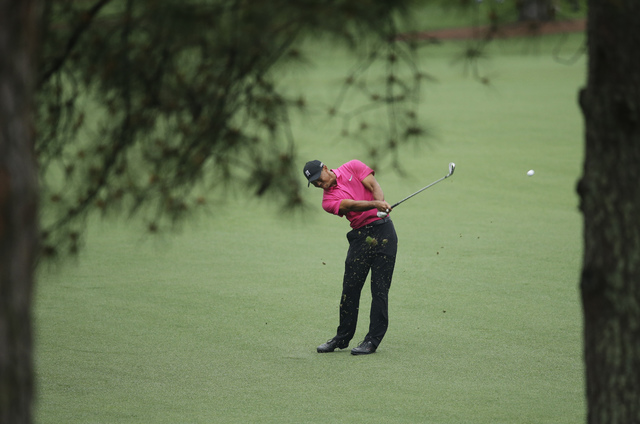AUGUSTA, Ga. — When Tiger Woods first started showing up at the Masters in the mid-1990s, he was a curiosity — a teenaged phenom, already famous for his amateur exploits, already shouldering expectations as a pioneering figure for African-Americans. In
AUGUSTA, Ga. — When Tiger Woods first started showing up at the Masters in the mid-1990s, he was a curiosity — a teenaged phenom, already famous for his amateur exploits, already shouldering expectations as a pioneering figure for African-Americans. In those early days, as when Woods first played here in 1995, and when he first won here in 1997, his father Earl was a constant presence around the golf course and in media reports.
In a sense, Woods has come full circle. Now 39, a four-time Masters champion and the undisputed best golfer of his generation, he returns to Augusta National this week as something of a curiosity again — winless at this tournament since 2005 and in all majors since 2008, invisible for the past two months as he rebuilt his game and his confidence in seclusion, and backed by a track record that includes just 111/2 competitive rounds since last July’s British Open.
And just to complete his circle of life, Woods is accompanied these days not by his father, who died in 2006, but by his children — Sam, 7, and Charlie, 6 — who will caddie for him Wednesday in the annual par-3 contest, which Woods typically skips.
“It’s nice to be able to share these things with my family,” Woods said Tuesday. “It just means the world to me.”
To judge by his first two days of practice at Augusta National this week, as well as by his demeanor in Tuesday’s news conference, Woods is in a good place both physically and mentally — a far cry from his last public showing, when he withdrew after 11 holes at Torrey Pines with an achy back and a butcher’s touch on his short game.
On Tuesday, playing for the second straight day with old buddy Mark O’Meara, Woods made an abbreviated trip around Augusta National, followed by a large, enthusiastic gallery, and his game showed no outward signs of trouble, either from the tees or fairways, or around the greens.
The Masters patrons are not the only ones curious about the state of Woods’s game as the tournament approaches; fellow tour pros, few of whom have laid eyes on Woods in the flesh in many months, are also intrigued. Many have greeted him warmly the past two days, but may have also been sizing him up.
“Just as a golf fan in general, I’m interested to see how he does when he comes back,” said world No. 1 Rory McIlroy, 25, who grew up idolizing Woods. “I had a good chat with him on the putting green today. He feels good. He’s been working hard. He’s got the motivation to keep at it, and just like everyone else, I’ll be looking for his score [to see how] he’s doing.”
“I hope he’s fine. I hope he will play well this week,” two-time major champion Martin Kaymer said. “But what would bother me a lot is all the speculation. You don’t have a choice — you will read about it somewhere. You will hear about it because you socialize with people. People ask you, so you don’t have a choice and you will [hear] it. So mentally, it must be quite exhausting.”
At his afternoon news conference, Woods was unusually congenial and expansive, smiling frequently, parrying playfully with reporters and speaking candidly about his struggles and the grueling efforts he undertook to escape them.
“I worked my [tail] off,” he said. There followed a heavy sigh, and an expanded answer: “People would never understand how much work I put into it to come back and do this again. But it was sunup to sundown.”
Woods went to great lengths to dispel the notion he was coming back too soon, simply because he couldn’t bear to miss a second consecutive Masters. No, he insisted, the only relevant factor was that his golf game was “finally ready to compete at this level, the highest level.” Asked if he would have skipped the tournament if he felt he wasn’t ready, he replied curtly: “Yes.”
Having once spent 683 weeks as the No. 1-ranked golfer in the world, including 281 weeks consecutively, Woods enters this Masters ranked a humble 111th, sandwiched between Japan’s Tomohiro Kondo and South African’s Henrik “Hennie” Otto.
In the ever-present chatter about who might win this week, seasoned observers might rattle off a half-dozen candidates — McIlroy, Bubba Watson, Dustin Johnson and Jordan Spieth being the most frequent — and never even breathe Woods’s name. With the exception of last year’s absence, he is as irrelevant to this tournament, from a competitive standpoint, as he has been at any point since 1995, when he was a 19-year-old debutant.
But then, come Thursday, the tournament will start, the galleries will assemble for his 1:48 p.m. tee time, and everyone — fans, media, fellow golfers — will be paying attention to Tiger Woods again. Could he shoot a pair of 80s and beat a hasty exit Friday afternoon? Could he shoot a pair of 68s and put himself in position for an epic weekend?
The thing is, you just don’t know.



